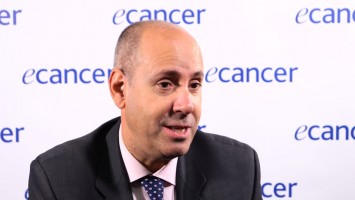I’m going to talk on these trial results using S1, it’s an oral 5FU, mainly conducted in Japan. This is our [?? 0:11]. The background, the standard adjuvant chemotherapy for hormone receptor positive HER2 negative breast cancer patients contains anthracycline and/or taxanes. Dose escalation of these chemotherapeutic agents may not be observed to be significant survival advantages. The chemotherapy with oral FU is active in the metastatic situation. The [?? 0:40] adjuvant trials have been conducted previously with oral 5FU captured on the positive signals and we hypothesised that the adjuvant treatment with S1 in conjunction with standard endocrine treatment would improve the survival outcomes of these patients.
This is the S1 formulation, it’s a biochemical modulatory agent consisting of tegafur, it’s 5FU, and the gimeracil oteracil, 1.4 and 1 ratio. S1 will be orally administered twice daily for 14 consecutive days. It’s a continuous oral administration and one week off, the Q3 regimen, and repeated for one year of time. The dose determination for each individual was done like this, using creatinine, it’s a renal function, and also the body surface area. Something like if the renal function is normal and the body surface area is 0.25 0.1 then we can start with 100mg per day.
This is our trial design simply comparing standard endocrine treatment and the S1 one year. The eligibility criteria was the stage 1-3 and the node positive and node negative and the intermediate or high risk patients were recruited to this trial. Randomisation was done one to one. The primary endpoint was invasive disease free survival and the secondary endpoints were the OS, the disease free survival or distant DFS, safety and biomarker things. The stratification factors were age, 55 years old, and also the nodal status, the chemotherapy plus or minus, the preoperative endocrine treatment plus or minus, oestrogen receptor status low or it’s not low and the institutions.
This is the statistical analysis planning. The control group, the five year IDFS was estimated as 83%, plus S1 87.8%. The hazard ratio was 0.7, it’s the target and at 0.5 the two sides. With five years of follow up and three years of enrolment 332 events were expected from the 915 patients.
Again, the key inclusion criteria – stage 1-3, if stage 3b medical dissection and after the systemic treatment PST is needed. With or without PST and within one year after surgery and within six months after starting adjuvant endocrine treatment you can start with S1.
This is our risk assessment for this particular trial. At the right hand side the results of the neoadjuvant systemic treatment, mainly chemotherapy. Without PST if the nodal involvement or lymphovascular invasion is positive by pathologists, it’s eligible. If it’s not grade 3 is eligible. Grade 2 over 2cm is elgible and grade 1 over 3 cm is eligible. But grade 2 less than 2cm and grade 1 2-3cm we used a Ki67 index – over 30% is eligible, if over 14% we used OncotypeDX testing. With PST neoadjuvant chemotherapy mainly if node positive or the breast residual disease positive, the non-pCR cases, it was eligible. With neoadjuvant endocrine treatment if node positive it’s eligible, if node negative we use the same criteria as without PST.
This is a consult diagram, the 1969 patients actually randomised. The full analysis set all together 1930. Equally randomised, the baseline demographic of these patients, the right hand side plus S1, 957 patients were randomised. Age 51; the premenopausal/postmenopausal 50/50; body weight 55kg on median and histological grade 1 is included at 10%, grade 2 60% and grade 3 25-26%. Nodal positivity is roughly 30% - one third was roughly node negative, two-thirds node positive. Ki67 labelling index less 14 54%, 14-30 31%, over 30 13%. Chemotherapy neoadjuvant 20%. Also the postoperative adjuvant chemotherapy is 35-36%. So roughly 55-56% were treated by chemotherapy in this trial. Base diameter less than 2cm 31%, over 3cm 21%.
This is our core or primary endpoint is disease-free survival. This trial was actually terminated early because the primary endpoint was met. In the interim analysis the median follow-up was 51 months and 155 events were identified in the control group and 101 in the S1 group. 81.6% in the control group is a five year IDFS and 87% in the S1 group. The hazard ratio is actually 0.63 and the p-value was less than 001.
Safety profile – S1 is a chemotherapeutic agent that caused bone marrow toxicity such as neutrophil counts decreased 42% all grades but grade 3 7.5%. So obviously significantly different. Plate decrease also were significantly different in all grades but grade 3 0.5%. GI toxicity is more frequent in the S1 treatment group and diarrhoea 32% all grades and 1.9% for grade 3, it’s statistically significant. Obviously hyperpigmentation was seen quite often in the S1 group, 53%.
As a conclusion the oral formulation continuous treatment, metronomic type treatment, with S1 one year adjuvant together with the endocrine treatment would be an important treatment option for oestrogen receptor positive HER2 negative primary breast cancer patients having intermediate high risk of recurrence. The safety profile was as expected and it’s quite manageable. That’s all. Thank you very much.








